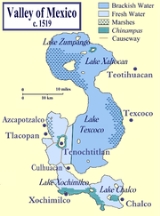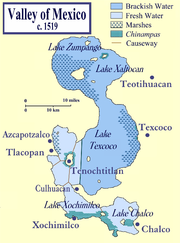
Xaltocan
Encyclopedia

Pre-Columbian
The pre-Columbian era incorporates all period subdivisions in the history and prehistory of the Americas before the appearance of significant European influences on the American continents, spanning the time of the original settlement in the Upper Paleolithic period to European colonization during...
city-state
City-state
A city-state is an independent or autonomous entity whose territory consists of a city which is not administered as a part of another local government.-Historical city-states:...
and island in the Valley of Mexico
Valley of Mexico
The Valley of Mexico is a highlands plateau in central Mexico roughly coterminous with the present-day Distrito Federal and the eastern half of the State of Mexico. Surrounded by mountains and volcanoes, the Valley of Mexico was a centre for several pre-Columbian civilizations, including...
, located in the center of Lake Xaltocan, part of an interconnected shallow lake system which included Lake Texcoco
Lake Texcoco
Lake Texcoco was a natural lake formation within the Valley of Mexico. The Aztecs built the city of Tenochtitlan on an island in the lake. The Spaniards built Mexico City over Tenochtitlan...
. The site was originally settled by the Otomi people
Otomi people
The Otomi people . Smaller Otomi populations exist in the states of Puebla, Mexico, Tlaxcala, Michoacán and Guanajuato. The Otomi language belonging to the Oto-Pamean branch of the Oto-Manguean language family is spoken in many different varieties some of which are not mutually intelligible.One of...
, but following a war in the late fourteenth century where the Otomi were defeated by an alliance of Tepanec
Tepanec
The Tepanecs or Tepaneca are a Mesoamerican people who arrived in the Valley of Mexico in the late 12th or early 13th centuries. The Tepanec were a sister culture of the Aztecs as well as the Acolhua and others—these tribes spoke the Nahuatl language and shared the same general pantheon, with...
s and Mexica
Aztec
The Aztec people were certain ethnic groups of central Mexico, particularly those groups who spoke the Nahuatl language and who dominated large parts of Mesoamerica in the 14th, 15th and 16th centuries, a period referred to as the late post-classic period in Mesoamerican chronology.Aztec is the...
the Otomi were driven off the island and relocated to Otumba
Otompan
Otompan or Otumba was a pre-Columbian altepetl or city-state in the upper Teotihuacan Valley...
, Metztitlan and Tlaxcala
Tlaxcala (Nahua state)
Tlaxcala was a pre-Columbian city state of central Mexico.Tlaxcala was a confederation of four altepetl — Ocotelolco, Quiahuiztlan, Tepeticpac and Tizatlan — which each took turns providing a ruler for Tlaxcala as a whole.-History:Tlaxcala was never conquered by the Aztec empire, but was...
. The island of Xaltocan was then resettled by Nahuatl
Nahuatl
Nahuatl is thought to mean "a good, clear sound" This language name has several spellings, among them náhuatl , Naoatl, Nauatl, Nahuatl, Nawatl. In a back formation from the name of the language, the ethnic group of Nahuatl speakers are called Nahua...
speakers.
Overview
Xaltocan is known to have been inhabited in the Postclassic period. Ceramics and other archaeological remains dating to this period have been recovered in excavations at the site. It is thought to have been a local center of power capable of exacting tribute from other city-states in the area.The founding of Xaltocan is described in the mytho-historical documents, the Historia Tolteca-Chichimeca
Historia Tolteca-Chichimeca
The Historia Tolteca-Chichimeca is a 16th century Nahuatl-language manuscript, dealing with the history of Cuauhtinchan. It is currently located in the Bibliothèque nationale in Paris. It is written by Fernando De Alva Ixtlixóchitl....
and Anales de Cuauhtitlan. According to the Anales the Xaltocameca (people of Xaltocan) were among the Chichimec tribes that left the mythical place of origin, Aztlán
Aztlán
Aztlán is the mythical ancestral home of the Nahua peoples, one of the main cultural groups in Mesoamerica. And, by extension, is the mythical homeland of the Uto-Aztecan peoples. Aztec is the Nahuatl word for "people from Aztlan".-Legend:...
, under a leader named Quauhtliztac ("White Eagle"). The Historia also identifies the Xaltocameca as belong to the Otomi ethnic group. In this document, written by Ixtlilxochitl
Fernando de Alva Cortés Ixtlilxochitl
Fernando de Alva Cortés Ixtlilxóchitl was a Novohispanic historian.-Life:A Castizo born between 1568 and 1580, Alva Cortés Ixtlilxóchitl was a direct descendant of Ixtlilxochitl I and Ixtlilxochitl II, who had been tlatoque of Texcoco...
, the first leader of the Xaltocameca is named as Iztacquauhtli, which also means "White Eagle" in Nahuatl.
In the 13th century Xaltocan were involved in a prolonged war with the Nahua city-state of Cuauhtitlan. Xaltocan was initially the strongest but around 1395 the ruler of Cuauhtitlan, Xaltemoctzin, allied himself with Tezozomoc of Azcapotzalco
Azcapotzalco
Azcapotzalco is one of the 16 delegaciones into which Mexico's Federal District is divided. Azcapotzalco is in the northwestern part of Mexico City...
and his subjects the Mexica
Mexica
The Mexica were a pre-Columbian people of central Mexico.Mexica may also refer to:*Mexica , a board game designed by Wolfgang Kramer and Michael Kiesling*Mexica , a 2005 novel by Norman Spinrad...
of Tenochtitlan and finally managed to conquer Xaltocan. The Otomi inhabitants fled north to the Otomian city-state of Metztitlan and to Tlaxcala
Tlaxcala
Tlaxcala officially Estado Libre y Soberano de Tlaxcala is one of the 31 states which along with the Federal District comprise the 32 federative entities of Mexico. It is divided into 60 municipalities and its capital city is Tlaxcala....
, while others were allowed to resettle on the lands of Texcoco in the place that was henceforth called Otumba
Otompan
Otompan or Otumba was a pre-Columbian altepetl or city-state in the upper Teotihuacan Valley...
- "Place of the Otomies".
During the next 100 years the site was resettled by Nahua peoples. After the Aztec Triple Alliance
Aztec Triple Alliance
The Aztec Triple Alliance, or Aztec Empire began as an alliance of three Nahua city-states or "altepeme": Tenochtitlan, Texcoco, and Tlacopan...
defeated the Tepanecs of Azcapotzalco, Xaltocan became an Aztec subject city and paid tribute to Tenochtitlan, mainly in the form of woven blankets. In 1521 during the Spanish conquest of Mexico
Spanish conquest of Mexico
The Spanish conquest of the Aztec Empire was one of the most important campaigns in the Spanish colonization of the Americas. The invasion began in February 1519 and was acclaimed victorious on August 13, 1521, by a coalition army of Spanish conquistadors and Tlaxcalan warriors led by Hernán Cortés...
the army of Hernán Cortés
Hernán Cortés
Hernán Cortés de Monroy y Pizarro, 1st Marquis of the Valley of Oaxaca was a Spanish Conquistador who led an expedition that caused the fall of the Aztec Empire and brought large portions of mainland Mexico under the rule of the King of Castile in the early 16th century...
razed Xaltocan and burned it to the ground.

